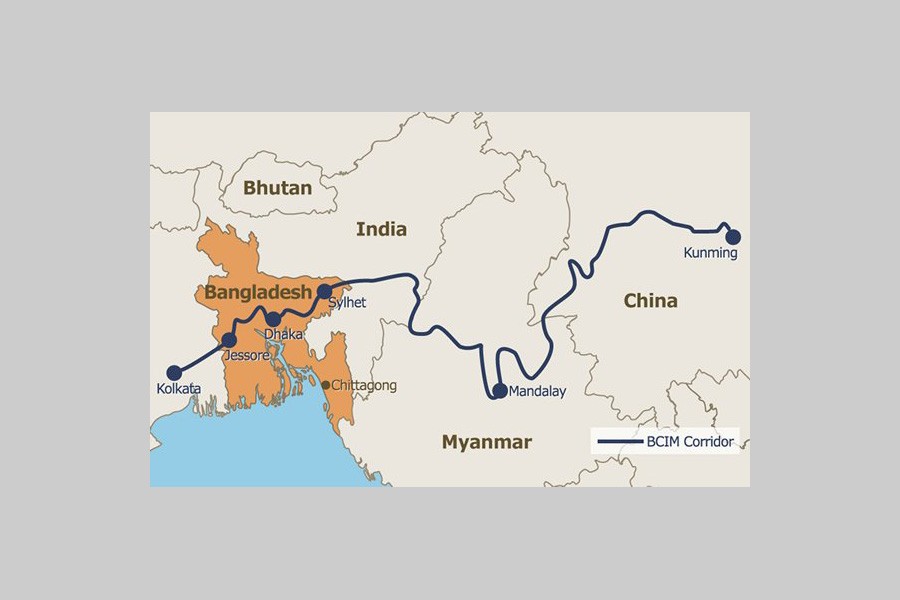
Published :
Updated :

The Bangladesh-China-India-Myanmar economic corridor (BCIM-EC) is a sub-regional initiative, earlier known as "Kunming Initiative", or BCIM Regional Economic Cooperation, was established in August 1999 in Kunming, capital of China's south-western Yunnan Province by the leaders of China, India, Bangladesh and Myanmar.
The idea of "multi-modal transport network", the pre-concept of BCIM economic corridor, was proposed in the 1990s by Professor Rehman Sobhan from Bangladesh in pursuit of boosting economic activities across the BCIM sub-region.
Chinese Premier Li Keqiang proposed the idea of economic corridor across the BCIM sub-region during his visit to India in May, 2013. The Joint Statement between China and India officially put forward the establishment of the BCIM-EC, while later Bangladesh and Myanmar offered strong and positive response towards the development of economic corridor across the sub-region.
The proposed BCIM economic corridor aims to construct a 2,800-km economic corridor connecting 20 major cities and towns of the BCIM countries. Starting from Kolkata, the capital of West Bengal, the corridor is planned to end in Kunming, capital of China's Yunnan Province via Bangladesh's Jessore, Dhaka, and Sylhet, Imphal of Manipur and Silchar of Assam in North Eastern part of India, and Myanmar's Ka Lay, Monywa, Mandalay, Lashio and Muse.
The BCIM Forum was primarily initiated with the aim of building regional cooperation among the four participating countries as well as integrating the BCIM economies through building overland economic corridor along the routes connecting the sub-region of South Asia, Southeast Asia, and East Asia.
The overland connectivity aside, over the years, the objectives of the BCIM-EC expanded in the areas of poverty alleviation, people-to-people connectivity, cross-border energy trade, tourism, human resource development, sustainable development as well as trans-border security.
Significant progress has already been witnessed towards the achievement of these objectives. As for example, starting from 1999 to 2015, twelve BCIM Forums have been arranged by the BCIM countries. The idea of the construction of Kunming-Mandalay-Dhaka-Kolkata (K2K) economic corridor was first proposed in the 9th BCIM Forum held in Kunming, China in 2011, which marked a significant milestone in the development of the economic corridor across the BCIM sub-region.
The 10th BCIM Forum held in Kolkata, India from February 18-19, 2012 was also crucial for taking the decision about the Kolkata to Kunming (K2K) Car Rally along the BCIM routes. The Car Rally held in February 2013 was warmly received by all four countries.
Subsequent to these developments, strengthening the working relationship between Track II and Track I and the initiation of Track I diplomacy through the consensus in 9th Forum and the 11th BCIM Forum respectively injected noteworthy impetus into the development of multimodal connectivity across the BCIM sub-region.
So far, three Joint Study Group (JSG) meetings have been conducted among the representatives of the four countries to foster physical connectivity, facilitate trade in goods, services and investment, promote economic integration, and also to enhance people-to-people contact among the BCIM countries.
The 1st JSG was held in Kunming, China from December 18-19, 2013, while the initiative was undertaken for the official launch of inter-governmental process of BCIM-EC. The 2nd JSG held in Bangladesh's Cox's Bazar from December 17-18, 2014 gained momentum after the consensus of the four countries to prepare separate country reports on the concept, scope and elements; principles and modalities of cooperation; and framework of cooperation. And, during the 3rd JSG meeting which held on 24- 25 April 2017 in Kolkata, the four countries agreed on upgrading the talks on BCIM-EC to the inter-governmental level.
The significance of the BCIM-EC is enormous. Geo-strategically, the economic corridor is the gateway to three sub-regions -- South Asia, Southeast Asia and East Asia. It is also the hub of blue economy and international maritime trade with the endowment of the Bay of Bengal and its adjacent areas -- the Indian Ocean and the Andaman and Nicobar Islands.
The greater connectivity through the BCIM-EC will be beneficial for India to be connected with North East Indian states and the outside world as well. Especially the small and medium scale industries of North Eastern states of India may promote their exports to Yunnan once the transport connectivity along the BCIM-EC is improved.
A southern corridor connecting Yunnan province to Chattogram is also significant for landlocked Yunnan Province to get connected with the Bay of Bengal and the Indian Ocean. Bangladesh can also be largely benefited by being linked with North East Indian region, Myanmar and China which will provide the space for increased cross-border trade and investment.
The geo-economic significance of the BCIM-EC is also immense. The BCIM sub-region with the enhanced transport connectivity can be a zone for international trade and business. The free flow of goods and services as well as cross-border trade and investment through seamless connectivity will facilitate equitable sharing of benefits among the BCIM countries. Most significantly, the seamless connectivity would offer Bangladesh and Myanmar to be benefited from greater access to two Asian economic giants -- China and India.
Although there are some impeding factors relating to security, economic and political relations, the BCIM countries need to come up with concrete measures to fully tap the potential of connectivity through successful establishment of the BCIM-EC across the sub-region.
Sultana Yesmin is a PhD candidate at the School of Politics and International Studies (SPIS), Central China Normal University, Wuhan, Hubei, China.


 For all latest news, follow The Financial Express Google News channel.
For all latest news, follow The Financial Express Google News channel.